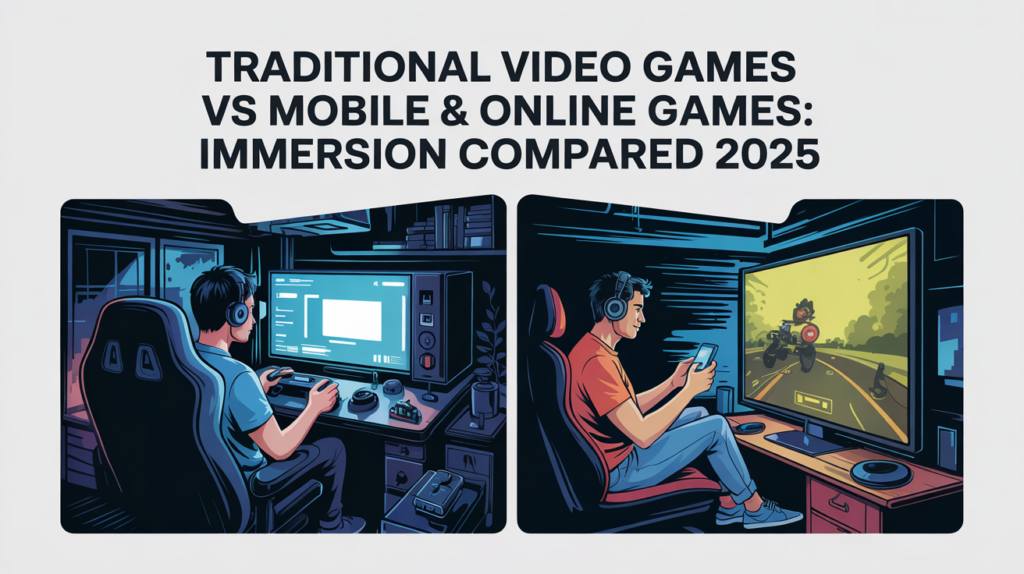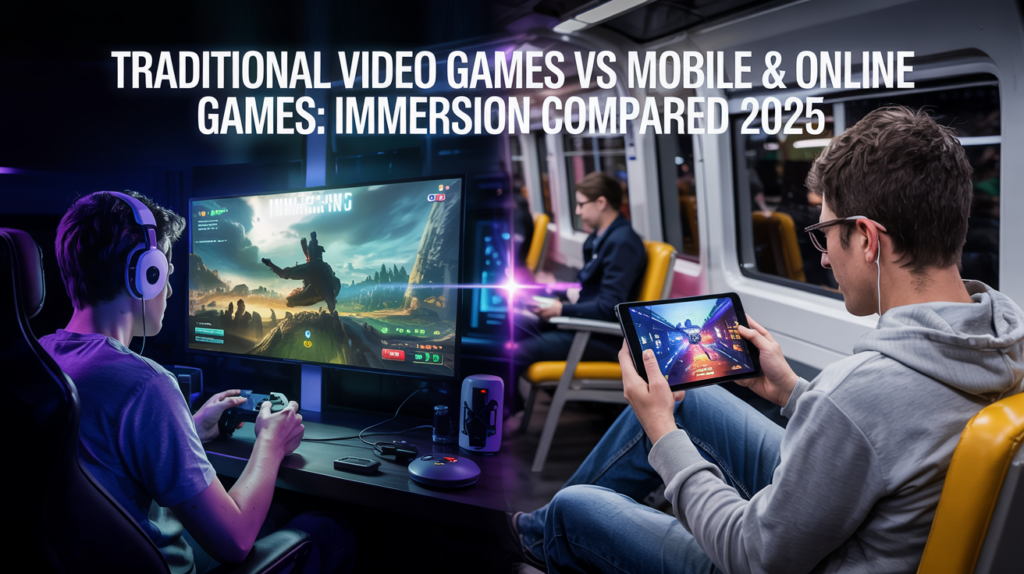Introduction
Ever got so hooked on a game that you forgot the world around you? That feeling—that deep, almost hypnotic focus—is what gamers call immersion. Whether you’re exploring a vast fantasy realm or solving a murder mystery in a dark cyberpunk alley, immersion is what turns a game into an experience. But not all games are created equal when it comes to drawing you in. So, how do traditional video games vs mobile & online games in terms of immersion?
Let’s dive deep into the heart of gaming and find out.
Table of Contents
Understanding the Gaming Categories

What are Traditional Video Games?
These are your classic console and PC games—think PlayStation, Xbox, Nintendo Switch, or gaming PCs. They usually require dedicated hardware, controllers, or keyboards and offer expansive, high-fidelity worlds.
What are Mobile Games?
Played on smartphones and tablets, mobile games are all about portability and convenience. From Candy Crush to Call of Duty: Mobile, they cater to everyone—casual and hardcore gamers alike.
What are Online Games?
Online games span across all platforms but are defined by their internet dependency. This includes MMOs, online shooters, and social games—anything where you’re constantly connected to a server and other players.
The Core of Immersion in Gaming
Audio-Visual Engagement
Immersive games don’t just look good—they feel alive. High-definition visuals, realistic sound design, and atmospheric music all contribute to a game’s ability to pull you in.
Narrative and Storytelling
A compelling story is the soul of immersion. Games that unfold like interactive movies can make you care about characters, decisions, and outcomes.
Game Mechanics and Controls
Smooth controls and intuitive mechanics are crucial. Laggy inputs or clunky UIs? Immersion killer.
Player Agency and Decision-Making
The more choices you’re allowed to make—and the more impact they have—the more connected you feel to the game world.
Immersion in Traditional Video Games
Console and PC Gaming Environments
Traditional gaming setups are immersive by design. You’re typically in a comfortable chair, big screen in front of you, controller or mouse in hand, ready to dive in.
Superior Graphics and Sound Systems
These platforms usually pack serious hardware. We’re talking 4K resolutions, ray tracing, surround sound—all the bells and whistles.
Deep Storylines and Character Development
Many traditional games offer rich narratives that evolve over hours of gameplay. Think The Witcher 3 or Red Dead Redemption 2—pure storytelling bliss.
Use of Peripherals and VR Tech
From steering wheels to VR headsets, traditional games have more immersive accessories that mobile simply can’t compete with.
Immersion in Mobile Games
Accessibility and Convenience
The biggest strength of mobile games? They’re always in your pocket. Waiting for the bus? Game on.
Short Play Sessions
Most mobile games are designed for quick bursts—perfect for killing time, but not always for deep immersion.
Casual vs. Hardcore Mobile Games
Some mobile games are surprisingly deep (Genshin Impact, anyone?), but many are light, simple, and fast-paced.
Distractions and Multitasking Impact
Text messages, calls, and app notifications constantly interrupt gameplay—definitely not helping the immersion.
Immersion in Online Games
Persistent Worlds and Real-Time Interaction
Online games often exist in worlds that keep evolving, even when you’re not playing. That sense of continuity can be very immersive.
Social Connection and Multiplayer Dynamics
Playing with (or against) real people adds unpredictability and depth. Whether it’s raiding with a guild or chatting in voice comms, social interaction boosts engagement.
Microtransactions and Their Psychological Effects
Frequent prompts to spend money can pull you out of the moment. It’s like being offered popcorn in the middle of a sword fight.
Device and Environment Influence
Screen Size and Input Methods
A 65-inch TV vs. a 6-inch phone screen—no contest. Plus, touchscreen controls often lack the precision of a controller or mouse.
Sound Quality and Control Feedback
Console games benefit from high-quality audio setups and haptic feedback that make you feel every gunshot or explosion.
Where and How We Play
Traditional gaming is usually done in a fixed space. Mobile gaming? Anywhere, anytime—though that often means less focus.
Psychological Engagement
Emotional Investment
Games with meaningful choices and emotional arcs are far more immersive—and traditional games usually have the upper hand here.
Flow State and Time Dilation
You ever play for “just 10 minutes” and look up two hours later? That’s flow, and it’s easier to enter in uninterrupted environments.
Sense of Presence in the Game World
When you feel like you’re in the game, not just playing it, that’s peak immersion. High-end graphics, deep stories, and rich worlds help a lot.
Challenges to Immersion
Ads and Monetization
Mobile games often bombard you with ads. That breaks flow faster than you can say “skip ad.”
Bugs and Performance Issues
Glitches and lag—no matter the platform—yank you out of the moment instantly.
Platform Limitations
Mobile hardware just can’t compete with consoles or PCs when it comes to running massive, high-fidelity worlds.
Technological Evolution and Immersion
Graphics Engines and Physics
Engines like Unreal and Unity are pushing boundaries, letting even mobile games look stunning—but consoles still lead the charge.
AI-Driven Storytelling
Dynamic NPCs and branching narratives are adding layers to immersion, especially in single-player experiences.
The Rise of Cloud Gaming
Now you can play console-quality games on your phone or tablet—immersion is going mobile, slowly but surely.
Future Trends
Blending Traditional and Mobile Experiences
Hybrid games that work across platforms (like Fortnite or Minecraft) are the future. One account, one world, everywhere.
Metaverse and Next-Gen Immersion
Imagine a persistent digital world that spans devices. We’re not there yet, but it’s coming.
Player Customization and Adaptive Environments
Games that evolve based on your choices? That’s the next frontier in keeping players glued to the screen.
Conclusion
So, in what ways do traditional video games differ from mobile and online games in terms of immersion? In a word—depth. Traditional games tend to offer richer narratives, better visuals, and more focused gameplay environments. Mobile and online games bring convenience, social interaction, and accessibility to the table, but often at the cost of depth and continuity.
That said, the lines are blurring. With advances in cloud gaming, AI, and mobile tech, we’re heading toward a future where every game can be immersive—no matter where or how you play it.
FAQs
1. What makes a video game immersive?
A combination of great visuals, sound, narrative, responsive controls, and a sense of presence within the game world.
2. Are mobile games becoming more immersive?
Yes, especially with titles like Genshin Impact and Call of Duty Mobile, but they still face hardware and attention-span challenges.
3. Can online games offer the same depth as traditional ones?
Absolutely, especially MMORPGs and story-rich multiplayer games, though it depends on the game design and community.
4. Why do some people prefer traditional gaming?
They often provide deeper stories, better graphics, and more immersive environments, perfect for long sessions.
5. Will mobile games ever replace console games?
Not entirely, but they’ll continue to grow and evolve alongside them—especially as tech improves.

